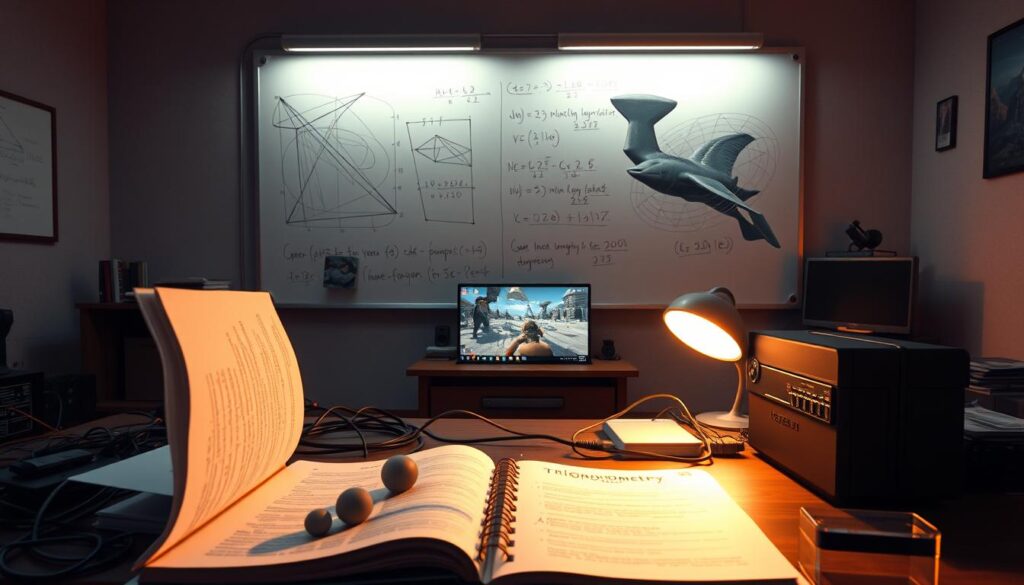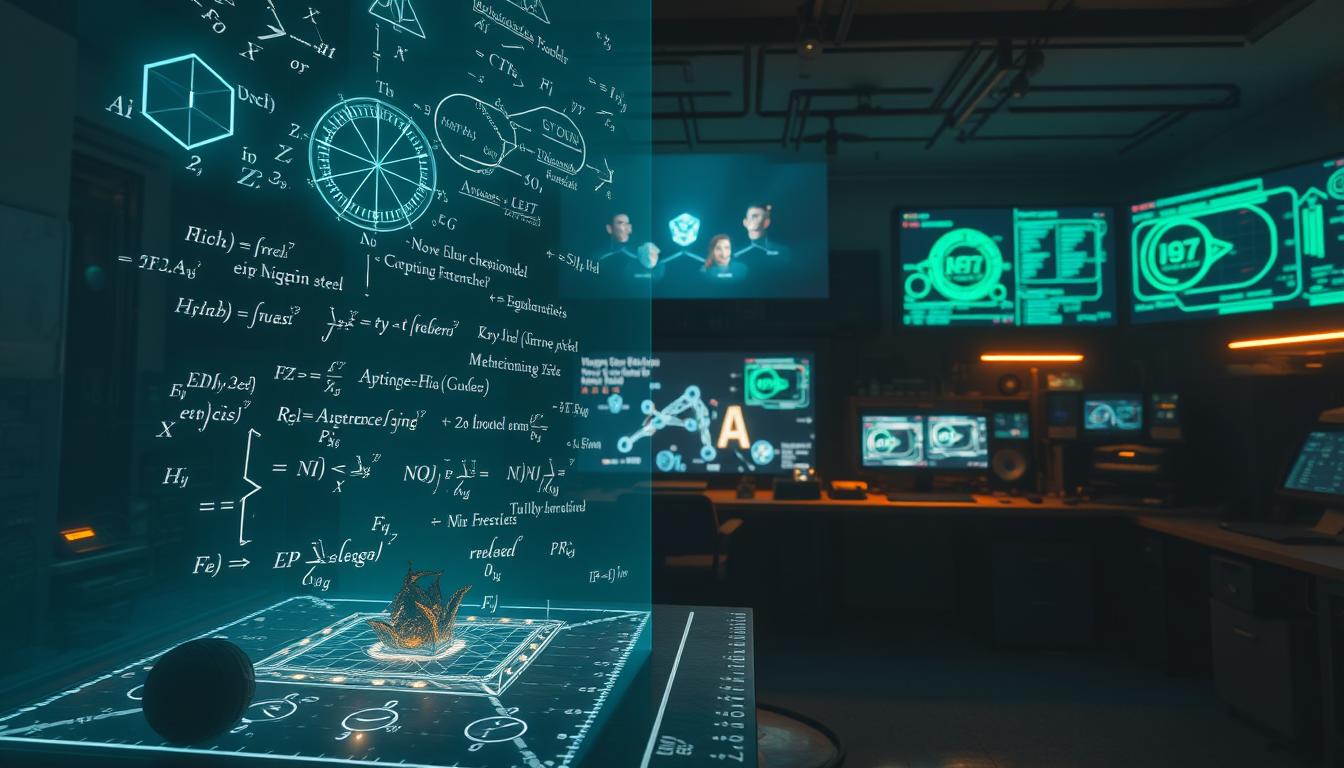Imagine stepping into a virtual world where characters move with lifelike fluidity, and environments respond to your every action. This is the magic of game development, where mathematics plays a crucial role in creating immersive experiences.
From simulating realistic physics to crafting intelligent AI, math is the unsung hero behind the scenes. It enables developers to craft engaging narratives, design intuitive controls, and build expansive game worlds that captivate players worldwide.
Key Takeaways
- Mathematics is essential for creating realistic physics in games.
- AI in games relies heavily on mathematical algorithms.
- Math helps developers create engaging gaming experiences.
- Game development involves various aspects that rely on mathematical concepts.
- Understanding math is crucial for game developers.
The Foundation of Game Development: Mathematical Principles
The use of mathematical principles in game development has revolutionized the industry, enabling the creation of complex and realistic game worlds. Mathematical concepts are the backbone of game development, influencing everything from physics and graphics to AI and game mechanics.
Core Mathematical Concepts Every Game Developer Should Know
Game developers should be familiar with core mathematical concepts such as vectors, matrices, and geometry. These concepts are crucial for creating 2D and 3D graphics, simulating physics, and implementing AI algorithms. For instance, vectors are used to represent positions, velocities, and directions in game worlds.
| Mathematical Concept | Application in Game Development |
|---|---|
| Vectors | Representing positions, velocities, and directions |
| Matrices | Performing transformations and projections |
| Geometry | Creating 2D and 3D graphics |
How Math Translates into Game Mechanics
Mathematical concepts are translated into game mechanics through various techniques, such as collision detection and response algorithms. These algorithms rely on mathematical formulas to determine when objects collide and how they respond to these collisions. For example, the use of vector operations enables developers to create realistic character movements and interactions.
The Role of Math in Game Development: From Physics to AI Within Games
Mathematics plays a crucial role in game development, from physics in game design to AI. The application of mathematical concepts has enabled the creation of sophisticated and realistic game environments.
Historical Evolution of Mathematics in Gaming
The historical evolution of mathematics in gaming has been significant. Early games used simple mathematical algorithms for basic calculations. Over time, as games became more complex, so did the mathematical models used. Today, games utilize advanced computational algorithms in gaming for physics, AI, and graphics rendering.

Why Mathematical Literacy Matters for Game Developers
Mathematical literacy is essential for game developers. It enables them to understand and implement complex algorithms, creating more realistic game worlds. Developers with a strong mathematical background can optimize game performance and innovate within the field, particularly in areas like AI in video games.
Vector Mathematics: The Building Blocks of Game Worlds
Vector mathematics is the backbone of game development, enabling the creation of immersive and interactive game worlds. It provides the mathematical framework necessary for handling positions, directions, and velocities within game environments.
Understanding Vector Operations in 2D and 3D Spaces
Vectors are mathematical objects that have both magnitude and direction. In game development, understanding how to perform operations on vectors, such as addition, subtraction, and scalar multiplication, is crucial. These operations allow developers to manipulate game elements in both 2D and 3D spaces effectively.
For instance, vector addition is used to update the position of a character based on its velocity. By adding the velocity vector to the character’s current position vector, developers can simulate movement.
Practical Applications of Vectors in Movement and Positioning
Vectors are used extensively in game development for movement and positioning. They enable developers to create complex movements and interactions within the game world. For example, vectors can be used to determine the trajectory of a projectile or to implement character movements that respond to user input.
By leveraging vector mathematics, game developers can create more realistic and engaging gameplay experiences. The precise control over game elements afforded by vector operations is essential for crafting immersive game worlds.
Physics Engines: Mathematical Models in Motion
Mathematical models are essential in physics engines, enabling game developers to create more realistic and engaging environments. Physics engines simulate real-world physics, making games more immersive and interactive.
Newtonian Physics in Game Environments
Newtonian physics forms the basis of many physics engines used in game development. It involves applying Newton’s laws of motion to simulate how objects move and interact within the game world. For instance, the trajectory of a projectile or the collision between two objects can be accurately modeled using these principles.

Collision Detection and Response Algorithms
Collision detection is a critical aspect of physics engines, determining when and how objects interact. Algorithms such as the Separating Axis Theorem (SAT) and GJK (Gilbert-Johnson-Keerthi) are commonly used for this purpose. These algorithms enable the game to respond realistically to collisions, enhancing the overall gaming experience.
Implementing Realistic Physics with Mathematical Formulas
To achieve realistic physics, developers rely on mathematical formulas to model complex phenomena. For example, rigid body dynamics and soft body simulations require sophisticated algorithms that account for factors like friction, elasticity, and gravity. By accurately implementing these formulas, games can achieve a high level of realism.
| Physics Engine Feature | Mathematical Basis | Application in Games |
|---|---|---|
| Rigid Body Dynamics | Newton’s Laws of Motion | Simulating realistic object interactions |
| Collision Detection | Separating Axis Theorem, GJK Algorithm | Determining object collisions and responses |
| Soft Body Simulations | Mass-Spring Systems, Finite Element Methods | Creating realistic deformations and movements |
Trigonometry and Geometry: Shaping Game Experiences
Game developers rely heavily on trigonometry and geometry to craft realistic environments. These mathematical disciplines are crucial for creating engaging and immersive game worlds.
Angular Calculations for Character Movement and Aiming
Trigonometry is essential for calculating angles and trajectories in games. It enables developers to create realistic character movements and aiming mechanics. For instance, angular calculations are used to determine the trajectory of projectiles, making gameplay more realistic.

Geometric Principles in Level Design and Object Placement
Geometry plays a vital role in level design and object placement. It helps developers create complex shapes and structures, enhancing the visual appeal of the game. Geometric principles are applied to ensure that objects interact realistically within the game environment.
| Mathematical Concept | Application in Games |
|---|---|
| Trigonometry | Character movement and aiming |
| Geometry | Level design and object placement |
By combining trigonometry and geometry, game developers can create more engaging and realistic game experiences. As noted by game development experts, “Mathematics is the backbone of game development, enabling the creation of immersive and interactive worlds.”
Linear Algebra: Transformations and Rendering
In the realm of game programming with mathematics, linear algebra plays a crucial role in transformations and rendering. It provides the mathematical framework necessary for manipulating objects in 2D and 3D spaces, enabling complex graphics and physics simulations.

Matrices and Their Role in Game Graphics
Matrices are fundamental in game graphics, serving as the primary tool for performing transformations such as rotation, scaling, and translation. By applying matrix operations, developers can manipulate objects in the game world efficiently. For instance, a rotation matrix can be used to rotate a character or object around a specific axis.
- Matrix multiplication allows for the combination of multiple transformations into a single operation.
- Inversion of matrices is used to reverse transformations, useful in scenarios like undoing a character’s movement.
Coordinate Systems and Transformations
Understanding coordinate systems is vital for game development. Transformations between different coordinate systems, such as from world space to screen space, are crucial for rendering. Linear algebra provides the tools to perform these transformations accurately.
- World space to view space transformation involves rotating and translating objects relative to the camera’s perspective.
- Projection transformation maps 3D objects onto a 2D screen, utilizing perspective or orthographic projections.
Shader Mathematics and Visual Effects
Shader mathematics is a critical aspect of modern game development, allowing for sophisticated visual effects. Shaders utilize linear algebra to perform calculations on a per-pixel or per-vertex basis, enabling effects like lighting, texture mapping, and shadow rendering.
By leveraging computational algorithms in gaming, developers can achieve realistic graphics and immersive experiences. The application of linear algebra in shader programming is a testament to the power of mathematical concepts in creating engaging games.
Probability and Statistics in Game Design
Understanding probability and statistics is essential for game developers aiming to create captivating games. These mathematical disciplines enable designers to craft engaging experiences, balance game mechanics, and create realistic environments.
Probability is crucial in game design for generating random events, such as loot drops or enemy spawn rates. Random Number Generation (RNG) is a key application of probability, influencing the unpredictability and replayability of games.
Random Number Generation and Its Applications
RNG is used in various aspects of game design, including loot systems and procedural generation. By leveraging RNG, developers can create diverse and dynamic content that keeps players engaged.
- Loot systems: RNG determines the rarity and type of items dropped by enemies or found in chests.
- Procedural generation: RNG is used to generate terrain, levels, or even entire game worlds.
Balancing Game Mechanics Through Statistical Analysis
Statistical analysis helps game developers balance game mechanics, ensuring that the game is neither too easy nor too difficult. By analyzing player data, developers can adjust game parameters to achieve the desired level of challenge and engagement.
| Statistic | Application | Benefit |
|---|---|---|
| Player win/loss rates | Adjusting difficulty levels | Enhanced player engagement |
| Time-to-complete levels | Optimizing level design | Improved player satisfaction |

Artificial Intelligence: Mathematical Foundations
The integration of artificial intelligence in video games has revolutionized the gaming industry, making it essential to understand its mathematical foundations. AI in games is not just about creating intelligent behaviors; it’s also about making those behaviors believable and engaging for players.

Pathfinding Algorithms: A* and Dijkstra’s Algorithm
Pathfinding is a critical aspect of game AI, enabling characters to navigate through the game world efficiently. Algorithms like A* and Dijkstra’s are widely used for this purpose. A* is particularly favored for its ability to find the shortest path between two points in a weighted graph or network, making it highly effective in game environments.
For instance, in a game where a character needs to move from one location to another while avoiding obstacles, A* algorithm calculates the most optimal route by considering the cost of reaching each node (such as distance or time) and an estimate of the cost to reach the destination from that node.
Decision Trees and State Machines
Decision trees and state machines are fundamental components of game AI, allowing for complex decision-making processes. Decision trees enable AI to make decisions based on a set of conditions, while state machines manage the different states an AI entity can be in, such as patrolling, chasing, or hiding.
“The use of decision trees and state machines in game AI allows for more realistic and varied behaviors, enhancing the overall gaming experience.”
Machine Learning Applications in Modern Games
Machine learning is increasingly being used in game development to create more sophisticated AI. Techniques such as reinforcement learning allow AI agents to learn from their interactions with the game environment, improving their performance over time.
| AI Technique | Application in Games |
|---|---|
| Pathfinding Algorithms | Navigation and Route Planning |
| Decision Trees | Complex Decision Making |
| Machine Learning | Adaptive AI Behaviors |
By leveraging these mathematical foundations, game developers can create AI that enhances gameplay, providing players with a more immersive and engaging experience.
Procedural Generation: Creating Worlds with Algorithms
Procedural generation has revolutionized game development by enabling the creation of vast, diverse game worlds through sophisticated algorithms. This technique leverages mathematical formulas and numerical methods to generate content on the fly, reducing the need for manual level design and enhancing gameplay variety.

Noise Functions and Terrain Generation
Noise functions, such as Perlin noise, are crucial in procedural generation for creating natural-looking terrain. These functions use mathematical algorithms to produce varied and realistic landscapes, from rolling hills to complex mountain ranges.
- Perlin Noise: Utilized for generating natural environments, it simulates the irregularities found in nature.
- Diamond-Square Algorithm: Another technique used for terrain generation, it creates realistic heightmaps for landscapes.
Mathematical Patterns for Content Creation
Mathematical patterns play a significant role in procedural generation, enabling the creation of diverse game content. By applying algorithms based on mathematical principles, developers can generate:
- Vegetation: Trees, grass, and other foliage can be algorithmically generated to create immersive environments.
- Structures: Buildings, ruins, and other architectural elements can be created using mathematical models, adding depth to game worlds.
By combining these techniques, game developers can craft unique, engaging, and varied game worlds that captivate players and enhance their gaming experience.
Optimization Techniques: The Math Behind Performance
Mathematical optimization is at the heart of game development, enabling developers to create complex, engaging, and efficient games. By leveraging mathematical techniques, developers can significantly enhance game performance, ensuring a smoother and more enjoyable experience for players.
Computational Complexity and Game Performance
Computational complexity plays a crucial role in determining game performance. Algorithms with high computational complexity can lead to increased latency and decreased frame rates, negatively impacting the gaming experience. Game developers must carefully analyze and optimize these algorithms to maintain performance. Techniques such as reducing the number of computations, using more efficient data structures, and exploiting parallel processing capabilities can help mitigate the impact of complex algorithms.
Mathematical Shortcuts and Approximations
Mathematical shortcuts and approximations are vital tools in optimizing game performance. By using approximations, developers can reduce the computational overhead associated with complex mathematical operations. For example, using linear approximations for non-linear functions or employing fast inverse square root algorithms can significantly improve performance. These techniques allow developers to strike a balance between accuracy and performance, ensuring that games run smoothly without sacrificing too much realism.
By applying these mathematical optimization techniques, game developers can create games that are not only visually stunning but also highly efficient, providing a better gaming experience for players.
Tools and Resources for Mathematical Game Development
Mathematical game development requires a robust set of tools and resources to bring complex ideas to life. With the increasing complexity of games, developers rely on a variety of mathematical concepts to create immersive experiences.
Game Engines and Math Libraries
Game engines like Unity and Unreal Engine provide extensive math libraries that simplify the implementation of mathematical concepts in game development. These libraries include functions for vector operations, physics simulations, and more, allowing developers to focus on creating engaging gameplay mechanics.
- Unity: Offers a comprehensive math library with support for vector math, matrix operations, and other essential mathematical functions.
- Unreal Engine: Includes robust mathematical tools and libraries, enabling developers to create complex, mathematically driven game mechanics.
Learning Resources for Game Development Mathematics
For developers looking to enhance their mathematical skills, there are numerous learning resources available. Online courses and tutorials on platforms like Coursera, Udemy, and Khan Academy cover a wide range of mathematical topics relevant to game development.
- Coursera: Offers courses on linear algebra, calculus, and other mathematical disciplines crucial for game development.
- Udemy: Provides tutorials and courses on applying mathematical concepts in game development, including physics and AI.
Debugging and Visualizing Mathematical Concepts
Debugging and visualizing mathematical concepts are critical steps in game development. Tools like Mathematica and MATLAB allow developers to visualize complex mathematical operations, aiding in the debugging process and ensuring that mathematical concepts are implemented correctly.
Conclusion: Embracing the Mathematical Foundation of Game Development
The importance of mathematics in gaming cannot be overstated. From the physics that govern the behavior of objects in a game world to the AI that drives character decision-making, mathematical concepts are the backbone of modern game development. By understanding and applying mathematical principles, game developers can create more engaging, realistic, and immersive experiences for players.
Game programming with mathematics enables developers to craft intricate game mechanics, simulate real-world phenomena, and push the boundaries of what is possible in interactive entertainment. The application of physics in game design, for instance, allows for the creation of believable environments and interactions that draw players into the game world.
As the gaming industry continues to evolve, the role of mathematics in game development will only continue to grow. By embracing the mathematical foundations of their craft, game developers can unlock new possibilities and create innovative gaming experiences that captivate audiences worldwide.
